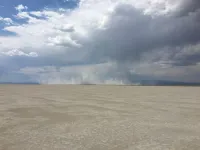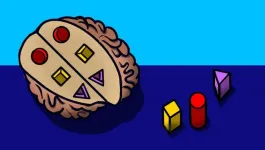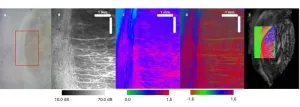(Press-News.org) As Utah’s Great Salt Lake shrinks, exposing more of its playa, concerns grow about the dust the dry lakebed emits. But scientists lack the data to fully understand what pollutants are present in these airborne sediments.
Researchers from the University of Utah are attempting to get a handle on this question and the latest findings are concerning.
Sediments in the lake’s exposed playa are potentially more harmful than other major dust sources affecting the Wasatch Front’s air quality, according to a study published online recently in the journal Atmospheric Environment.
These sediments, when aerosolized, show higher levels of reactivity and bioavailability when compared to sediments collected from other spots upwind of Utah’s major population center along the Wasatch Front. Chemical analysis also indicated the presence of numerous metals, and levels of arsenic and lithium that exceed the U.S. Environmental Protection Agency’s soil residential regional screening levels.
“You’re talking about a very large dust source located next to a very large population, and you’ve got elevated levels of manganese, iron, copper and lead. Lead is a concern for developmental reasons,” said senior author Kerry Kelly, a professor of chemical engineering. “Manganese, iron and copper, these are transition metals and are known to be very irritating to your lungs. Once you get irritation, that can lead to this whole inflammatory response. And that’s part of the problem with particulate matter and it’s adverse health effects like asthma.”
The Great Salt Lake is a terminal body receiving runoff from a vast drainage basin spanning northern Utah and parts of three other states. Metals from natural sources and human disturbances are pushed into lake from inflows or atmospheric deposition, and these materials accumulate in the lakebed. The potential for harmful dust pollution has become a priority for Utah state officials, who issued a list of priorities aimed at tackling the problem.
Another recent study led by sociology professor Sara Grineski found dust from the lakebed disproportionately affects disadvantaged neighborhoods in Salt Lake County.
In a separate forthcoming study led by U biologist Michael Werner’s lab, another team of researchers characterized levels of toxic metals deposited in submerged lakebed sediments sampled during the lake’s record low-water year of 2021, noting how these levels have changed since the years of Utah’s mining era. Concentrations of some metals, such as lead and zinc, appear to have decreased, likely a reflection of the decline in the region’s mining activity, while mercury levels surprisingly have increased.
Researchers cautioned that they can’t conclude whether these pollutants are actually being blown into populated areas during wind events because the monitoring equipment to capture that dust has yet to be adequately deployed downwind of the lake. Most high-wind events arrive from the southwest, blowing for several hours off the lake north into Weber or Box Elder County, before shifting to the south as the front passes through.
To conduct the published study, Kerry Kelly’s lab, which specializes in air quality, teamed up with researchers in the U’s College of Science. They examined previously collected sediment samples from the Great Salt Lake, comparing them with sediments from other dust sources in the Great Basin, namely Sevier Lake, Fish Springs Lake and West Desert in western Utah and Tule Lake in northeastern California. These places are known to contribute to dust pollution reaching Salt Lake City.
In recent years, co-author Kevin Perry, a professor of atmospheric sciences, has systematically gathered exposed lakebed sediments, logging hundreds of miles on a bike. His prior research has identified “hotspots” on the playa that appear to be enriched with potentially toxic elements.
Only 9% of the exposed lakebed, or 175 square kilometers (about 43,000 acres), is emitting dust from areas where lakebed crusts are disturbed, according to Perry. The rest of the playa is covered in a natural hardened layer that keeps the sediments in place. Perry’s ongoing research examines what happens to the playa crusts over time. He said his initial findings indicate the broken layers reset fairly easily, suggesting the playa’s threat to air quality may not be as dire as previously thought.
The latest study is the first to analyze the dust’s “oxidative potential,” a measure of its ability to react with oxygen.
“When you breathe in something that’s really reactive, it’s going to interact with the cells inside your lungs and it’s going to cause damage,” Kelly said.
In the lab, the team aerosolized the sediment samples to isolate the particles that are small enough to inhale and lodge in lung tissue, those smaller than 10 micrometers or PM10.
These particles were captured on filters and further analyzed using a method called inductively coupled mass plasma mass spectrometry to determine their elemental makeup and other tests to determine their oxidative potential (OP) and bioaccessibility.
“We devised a way to dissolve the metals using increasingly caustic acids to figure out at what level these metals leaching from the particles,” Perry said. “It turns out that the dust from Great Salt Lake has more leachable metals that are bioavailable than we would wish.”
Meanwhile, high OP was detected in dust associated with certain metals, including copper, manganese, iron and aluminum.
The study, titled “Assessing the oxidative potential of dust from Great Salt Lake,” will appear in the November 2024 print edition of the journal Atmospheric Environment. The research team included Reuben Attah and Kamaljeet Kaur of the Department of Chemical Engineering and Diego Fernandez of the Department of Geology & Geophysics. Funding was provided by the U’s Wilkes Center for Climate Science and Policy and the National Science Foundation.
END
Just how dangerous is Great Salt Lake dust? New research looks for clues
Utah scientists find sediments from the lake’s growing exposed playa have elevated 'oxidative potential,' indicating greater risk to human health.
2024-09-07
ELSE PRESS RELEASES FROM THIS DATE:
Maroulas appointed Associate Vice Chancellor, Director of AI Tennessee
2024-09-06
The University of Tennessee, Knoxville, has appointed Vasileios Maroulas associate vice chancellor and director of the AI Tennessee Initiative. AI Tennessee was established in 2022 to strengthen UT’s research in AI, expand the number of UT students developing AI skills and competencies, and position the state of Tennessee as a national and global leader in the data-intensive knowledge economy.
“I look forward to advancing UT into a leader for AI research, innovation, and education,” said Maroulas. “By harnessing the power of transdisciplinary research, pioneering new learning ...
New chickadee research finds cognitive skills impact lifespan
2024-09-06
New chickadee research finds cognitive skills impact lifespan
Working ‘smarter’ not harder important to natural selection and survival rates
While there is no denying ‘survival of the fittest’ still reigns supreme in the animal kingdom, a new study shows being smartest – or at least smarter – is pretty important, too.
Western University animal behaviour and cognition researcher Carrie Branch and her collaborators at the University of Nevada, Reno and the University of Oklahoma tracked the spatial cognition and ...
Cognitive behavioral therapy enhances brain circuits to relieve depression
2024-09-06
Cognitive behavioral therapy, one of the most common treatments for depression, can teach skills for coping with everyday troubles, reinforce healthy behaviors and counter negative thoughts. But can altering thoughts and behaviors lead to lasting changes in the brain?
New research led by Stanford Medicine has found that it can — if a therapy is matched with the right patients. In a study of adults with both depression and obesity — a difficult-to-treat combination — cognitive behavioral therapy that focused on problem ...
Terasaki Institute awarded $2.3 Million grant from NIH for organ transplantation research using organs-on-a-chip technology
2024-09-06
September 6, 2024 —Researchers at the Terasaki Institute for Biomedical Innovation have been awarded a multi-million grant from the National Institutes of Health (NIH) to advance research in organ transplantation and antibody-mediated rejection. This funding will facilitate the development of an innovative multi-organs-on-a-chip platform aimed at transforming our understanding of transplant rejection and immune tolerance.
Organ transplantation is widely recognized as the most effective treatment for organ failure. However, the need for lifelong immunosuppressive ...
Atoms on the edge
2024-09-06
Typically, electrons are free agents that can move through most metals in any direction. When they encounter an obstacle, the charged particles experience friction and scatter randomly like colliding billiard balls.
But in certain exotic materials, electrons can appear to flow with single-minded purpose. In these materials, electrons may become locked to the material’s edge and flow in one direction, like ants marching single-file along a blanket’s boundary. In this rare “edge state,” electrons can flow without ...
Postdoc takes multipronged approach to muon detection
2024-09-06
NEWPORT NEWS, VA – When Debaditya Biswas was a high school student in India, his math teacher, Dr. Satyabrata Das, sparked his interest in physics.
“Before I joined his class, I was really not sure what I was going to do in life,” said Biswas, a postdoctoral research associate at Virginia Tech. “He revealed the beauty of science to me.”
Now, as the 2024 Jefferson Science Associates (JSA) Postdoctoral Prize winner, Biswas hopes to reveal a new method for the U.S. Department of Energy's Thomas Jefferson National Accelerator Facility to detect muons.
By themselves, muons aren’t actually that difficult for physicists to detect. They are a type ...
Mathematical proof: Five satellites needed for precise navigation
2024-09-06
As a rule, GPS indicates our location with an accuracy of just a few meters. But we have all experienced situations where the possible error increases to a few hundred meters or the indicated location is simply wrong. One reason for this can be the small number of satellites with line-of-sight contact to the navigation device or unfavorable relative alignment of the satellites.
How does GPS work?
GPS satellites are equipped with an extremely accurate atomic clock and know their positions at all times. They continually transmit the time and their location using radio waves. A mobile phone ...
Scalable, multi-functional device lays groundwork for advanced quantum applications
2024-09-06
Researchers have demonstrated a new multi-functional device that could help advance the scalability of solid-state color centers, enabling them to be used in larger and more complex quantum computers and networks. As efficient photon-spin interfaces, solid-state color centers are promising candidates for qubit nodes — essential units for storing and processing quantum information.
Solid-state color centers are point defects that can absorb and emit light at specific wavelengths. To be useful in real-world quantum applications, they must be optically addressable in a fast and controllable manner while also allowing ...
Falling for financial scams? It may signal early Alzheimer’s disease
2024-09-06
Older adults who are more vulnerable to financial scams may have brain changes linked to a higher risk of Alzheimer’s disease, according to a first-of-its-kind study led by researchers at the USC Dornsife College of Letters, Arts and Sciences.
Nearly 7 million Americans are living with Alzheimer’s disease, the fifth leading cause of death among those 65 and older. The disease will carry an estimated $360 billion in health care costs this year alone, according to the Alzheimer’s Association.
Researchers led by Duke Han, professor ...
Integrating MRI and OCT for new insights into brain microstructure
2024-09-06
In a new study, researchers compared the orientations of nerve fibers in a human brainstem using two advanced imaging techniques: diffusion magnetic resonance imaging (dMRI)-based tractography and polarization sensitive optical coherence tomography (PS-OCT). The findings could aid in combining these techniques, which each offer unique advantages, to advance our understanding of the brain’s microstructure and help inform new techniques for early diagnosis of various brain disorders.
Isabella Aguilera-Cuenca from ...
LAST 30 PRESS RELEASES:
Magnetic avalanches power solar flares
LeapSpace goes live: the Research-Grade AI-Assisted Workspace built on trusted science
DNA tests reveal mysterious beluga family trees
Strategic sex: Alaska’s beluga whales swap mates for long-term survival
How early cell membranes may have shaped the origins of life
Cannabis legalization is driving increases in marijuana use among U.S. adults with historically lower consumption rates
Multifunctional dipoles enabling enhanced ionic and electronic transport for high‑energy batteries
Triboelectric nanogenerators for future space missions
Advancing energy development with MBene: Chemical mechanism, AI, and applications in energy storage and harvesting
Heteroatom‑coordinated Fe–N4 catalysts for enhanced oxygen reduction in alkaline seawater zinc‑air batteries
Meta-device for precision lateral displacement sensing
Plasma-guided mitotane for the treatment of adrenocortical carcinoma: adjuvant care to advanced disease
Theoretical study of laser-enhanced nuclear fusion reactions
Social environment impacts sleep quality
Optimized kinetic pathways of active hydrogen generation at Cu2O/Cu heterojunction interfaces to enhance nitrate electroreduction to ammonia
New design playbook could unlock next generation high energy lithium ion batteries
Drones reveal how feral horse units keep boundaries
New AI tool removes bottleneck in animal movement analysis
Bubble netting knowledge spread by immigrant humpback whales
Discovery of bats remarkable navigation strategy revealed in new study
Urban tributaries identified as major sources of plastic chemical pollution in the Yangtze River
UK glaucoma cases higher than expected and projected to reach 1.6 million+ by 2060
Type 2 diabetes prevention could more than halve carbon footprint linked to disease complications
Over 1 million estimated to have glaucoma in UK
Early treatment can delay rheumatoid arthritis for years
National childhood type 1 diabetes screening is effective and could prevent thousands of emergency diagnoses, UK study shows
Mix of different types of physical activity may be best for longer life
Continuous care from community-based midwives reduces risk of preterm birth by 45%
Otago experts propose fiber as first new essential nutrient in 50 years
Auburn Physics PhD student earns prestigious DOE Fellowship
[Press-News.org] Just how dangerous is Great Salt Lake dust? New research looks for cluesUtah scientists find sediments from the lake’s growing exposed playa have elevated 'oxidative potential,' indicating greater risk to human health.







